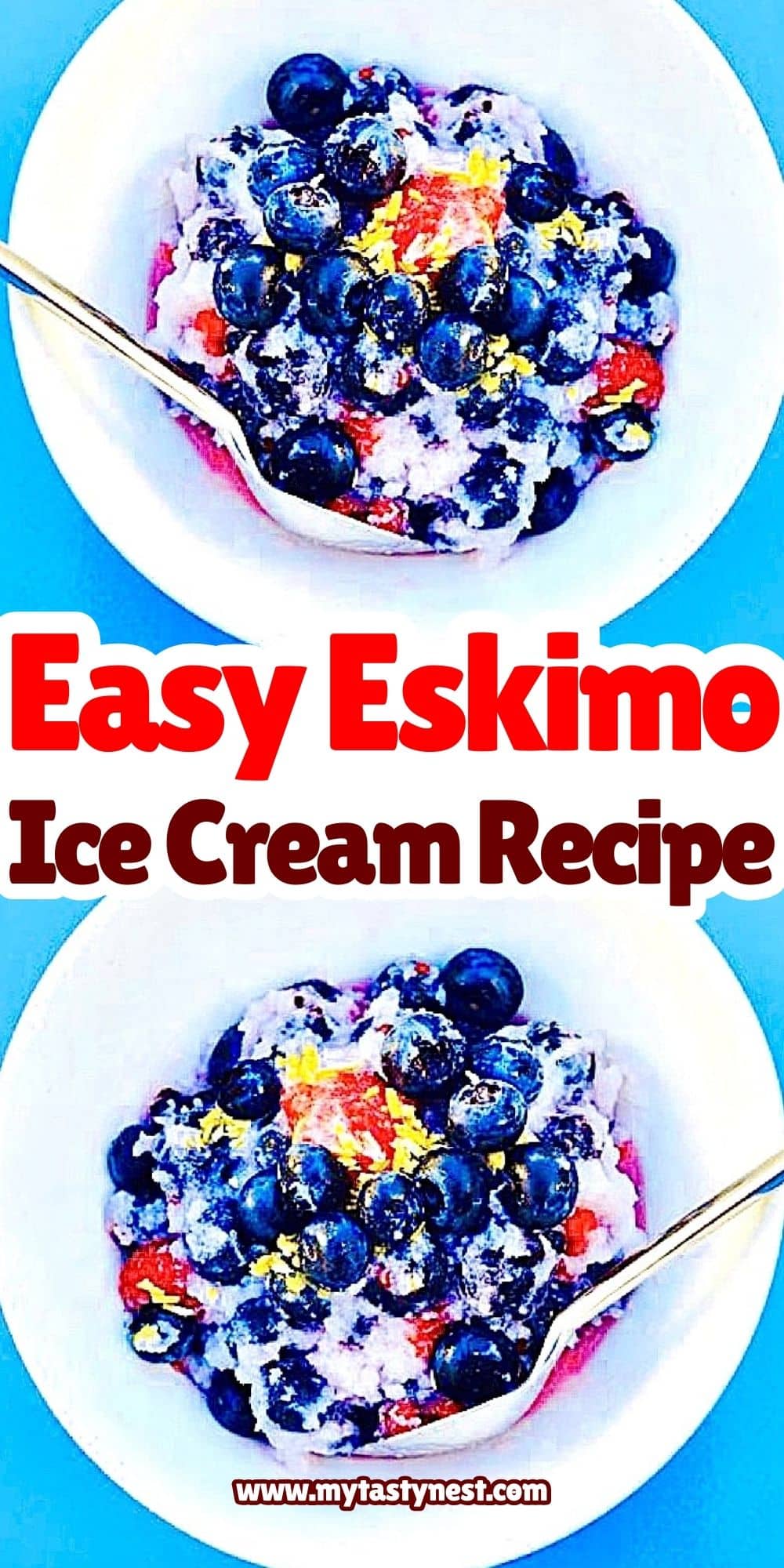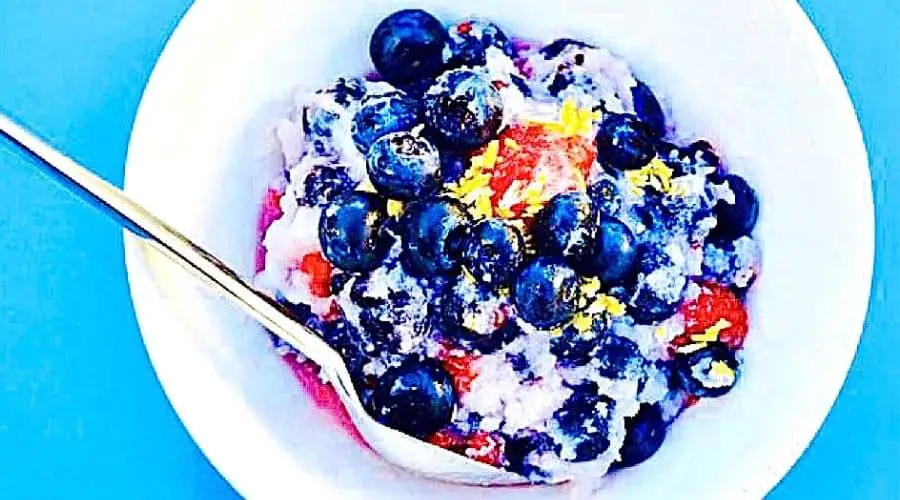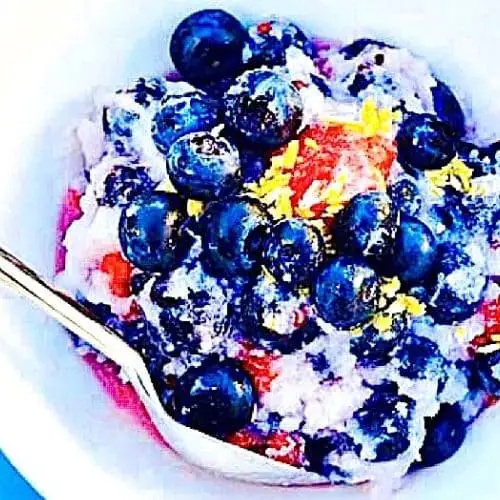All products are selected by our editorial team for quality. If you buy through our links, we may earn a small commission at no extra cost to you.
Eskimo Ice Cream, also known as Akutaq (pronounced Ah-goo-duck), is a cherished traditional dessert among Alaska Native communities.
Unlike the dairy-based ice cream many are familiar with, Akutaq is made from a unique blend of animal fat, snow or water, and wild berries, sometimes even incorporating fish.
This dish has been a vital part of indigenous survival in the Arctic for centuries.
Originally crafted as a high-energy food to sustain hunters and travelers in freezing conditions, it has since become a cultural symbol, passed down through generations.
Today, variations of Eskimo Ice Cream range from the classic, nutrient-dense versions to modern adaptations using vegetable shortening and sugar for a milder taste.
Whether you’re curious about trying an authentic taste of Alaska or simply looking for a new way to enjoy frozen treats, this recipe offers a fascinating glimpse into Arctic culinary traditions.

What is Eskimo Ice Cream (Akutaq)?
Eskimo Ice Cream, or Akutaq, is more than just a dessert—it’s a traditional Alaskan dish with deep cultural roots.
The word “Akutaq” means “to mix” in the Yupik language, referring to the whipping process that gives the dish its airy, creamy texture.
Origins and Cultural Significance
For centuries, Alaska Natives, including the Inuit, Yupik, and Athabaskan peoples, have made Akutaq using ingredients available in their harsh, frozen environment.
It was originally a portable, high-energy food consumed during hunting trips.
The combination of fat and berries provided essential nutrients, helping sustain energy levels in extreme Arctic conditions.
Beyond its practicality, Akutaq holds an important cultural and ceremonial role.
It is often served at gatherings, celebrations, and potlatches, where families and communities come together to share traditional foods.
Traditional vs. Modern Variations
Traditional Eskimo Ice Cream varies depending on regional availability of ingredients.
Some classic versions include:
- Fat-based Akutaq – Made with reindeer, seal, or bear fat, along with snow and berries.
- Fish-based Akutaq – Some communities mix white fish like pike or sheefish into the dessert for added protein.
Modern adaptations replace animal fat with vegetable shortening, butter, or Crisco, making it more accessible for those outside of Alaska.
Many also add sugar or sweeteners to balance the natural tartness of the berries.
Despite these adaptations, the heart of Akutaq remains the same: a whipped, creamy, and deeply traditional dish that connects generations to their heritage.
Ingredients Needed for Eskimo Ice Cream
The ingredients for Eskimo Ice Cream, or Akutaq, can vary depending on whether you’re making a traditional version or a modern adaptation.
Below are the key components for both.
Traditional Ingredients
Historically, Alaska Native communities used ingredients sourced from their environment.
These included:
- Animal Fat – Seal, caribou, reindeer, or bear fat, which provides energy and a smooth texture.
- Snow or Water – Used to create a creamy consistency.
- Wild Berries – Cloudberries, salmonberries, blueberries, or cranberries, which add natural sweetness and nutrition.
- Fish (Optional) – Some versions include finely shredded white fish (such as pike or sheefish) for added protein.
Modern Ingredients (Home-Friendly Version)
For those outside of Alaska or looking for a more accessible version, these substitutes work well:
- Vegetable Shortening (Crisco) or Butter – Replaces traditional animal fat while still creating a smooth, airy texture.
- Cold Water or Milk – Helps achieve the right consistency.
- Fresh or Frozen Berries – Blueberries, raspberries, or strawberries work well.
- Sugar or Honey (Optional) – To add sweetness, though traditional Akutaq relies on the berries’ natural flavor.
Now that we have all the ingredients, let’s go through the step-by-step process of making this unique ice cream.
Step-by-Step Instructions to Make Eskimo Ice Cream

Making Eskimo Ice Cream involves whipping fat and liquid together until fluffy, then folding in berries (and fish, if using).
Here’s how to do it:
Step 1: Prepare the Base
- If using animal fat, render it first by melting it over low heat, then let it cool until semi-solid. If using vegetable shortening, let it soften at room temperature.
- In a large mixing bowl, add the softened fat and a small amount of cold water or milk.
Step 2: Whip Until Fluffy
- Use a whisk, hand mixer, or stand mixer to beat the fat and liquid until it turns light, fluffy, and white. This can take 10–15 minutes.
- If needed, add more water a tablespoon at a time to achieve a smooth consistency.
Step 3: Add Berries (and Fish, If Using)
- Gently fold in the wild berries, making sure they distribute evenly without crushing them.
- (Optional) If adding fish, ensure it is cooked and finely shredded before mixing it in.
Step 4: Chill and Serve
- Transfer the mixture to a bowl and let it chill in the refrigerator for at least an hour. This allows the flavors to meld together.
- Serve cold as a refreshing treat! Traditionally, Akutaq is eaten with a spoon straight from a communal bowl.
Eskimo Ice Cream is best enjoyed fresh but can be stored in an airtight container in the fridge for up to 3 days. Avoid freezing, as this can alter the texture.
Tips for the Best Homemade Eskimo Ice Cream
Creating the perfect batch of Eskimo Ice Cream requires a little patience and attention to detail.
Here are some tips to help you make the best Akutaq, whether you’re following a traditional recipe or putting your own twist on it.
1. Choose the Right Fat
The fat used in Eskimo Ice Cream is critical for both texture and flavor.
Traditional animal fats like reindeer or seal fat offer an authentic, rich flavor but can be hard to find outside of Alaska.
If using vegetable shortening (Crisco) or butter, opt for the highest quality you can find.
The fat should be soft enough to whip easily, creating that light, airy texture.
2. Whip the Mixture Thoroughly
The key to the fluffy texture of Eskimo Ice Cream is thorough whipping.
Make sure to beat the fat and liquid mixture until it’s light and fluffy—this can take some time (about 10–15 minutes).
Using a hand or stand mixer will make this process easier and help achieve the perfect consistency.
3. Don’t Skip the Chilling Step
While Eskimo Ice Cream is best served fresh, chilling the mixture for an hour or so after preparing allows the flavors to meld together.
This also helps to firm up the texture, making it easier to scoop and serve.
4. Use Fresh, Sweet Berries
For the best flavor, opt for fresh or frozen berries that are ripe and sweet.
Wild berries, such as cloudberries, blueberries, or salmonberries, add a natural sweetness and slight tartness that balance out the richness of the fat.
If you can’t find wild berries, any fresh, flavorful berry will do—just try to avoid ones that are overly tart.
5. Adjust the Sweetness to Your Taste
Traditional Eskimo Ice Cream is not overly sweet.
If you prefer a sweeter version, feel free to add a little sugar, honey, or maple syrup to the base.
Start with a small amount and taste as you go to find your ideal level of sweetness.
6. Use Cold Water or Milk
For the smoothest texture, make sure the water or milk you add to the mixture is cold.
This will help the fat combine better with the liquid, resulting in a silky, creamy consistency.
7. Serve in Traditional Ways
For an authentic experience, serve your Eskimo Ice Cream in a communal bowl or on a large platter.
Traditionally, it is eaten with a spoon and shared among friends and family, making it as much about the experience as the food itself.
Eskimo Ice Cream Variations You Can Try
While traditional Eskimo Ice Cream (Akutaq) is a beloved part of Alaska Native culture, there are many ways you can put your own spin on the recipe.
Here are some fun variations to try:
1. Classic Alaskan Akutaq
Stick to the traditional version for the most authentic taste. Use seal, caribou, or reindeer fat, and fresh wild berries like salmonberries or cloudberries.
You can also add fish, like whitefish or pike, for a truly traditional touch.
2. Vegetarian-Friendly Akutaq
For those who prefer a vegetarian or vegan version, substitute the animal fat with vegetable shortening (Crisco) or coconut oil.
These options create a similar texture without compromising the fluffiness of the ice cream.
The richness of coconut oil, in particular, can add a pleasant flavor.
3. Sweetened Dessert Version
Traditional Eskimo Ice Cream is not overly sweet, but if you have a sweet tooth, you can add sugar, honey, or maple syrup to the mixture for a more dessert-like version.
Pair it with sweetened condensed milk or vanilla extract for extra flavor depth.
4. Berry Mix Akutaq
Try mixing several types of berries for a fruit-forward version of Eskimo Ice Cream.
Combine blueberries, raspberries, and strawberries for a colorful, tangy treat.
You can even add a few chopped pieces of fruit like mango or peach for a twist.
5. Frozen Akutaq Pops
Want to make this treat even more fun? Turn your Akutaq into frozen ice cream pops! Simply pour the mixture into ice pop molds and freeze for several hours.
These homemade ice pops are perfect for a hot day or as a unique party treat.
6. Nutty Akutaq
For some extra texture, add chopped nuts like walnuts, almonds, or pecans to the Eskimo Ice Cream.
These will give a delightful crunch, making each bite more interesting while still complementing the creamy consistency.
Conclusion
Eskimo Ice Cream, or Akutaq, is more than just a unique frozen treat—it’s a window into the rich cultural traditions of Alaska Native peoples.
This dish, made from a mixture of fat, berries, and sometimes fish, has been nourishing generations of Arctic communities for centuries.
Whether you’re drawn to its historical significance or curious about trying a truly one-of-a-kind dessert, making Akutaq at home offers a fun and rewarding experience.
From the traditional methods to modern adaptations, Eskimo Ice Cream is a versatile and creative way to explore new flavors.
Whether you keep it simple with just berries and fat or experiment with different textures and sweetness levels, the possibilities are endless.
Gather your ingredients, follow the steps, and enjoy this delightful treat that’s steeped in history and rich in flavor.
We hope this guide inspires you to bring a piece of Alaskan culture into your kitchen.
Don’t forget to share your creations with family and friends—and let us know how you made it your own!
Frequently Asked Questions (FAQs)
1. Can I make Eskimo Ice Cream without animal fat?
Yes! If you prefer a vegetarian or vegan version, you can substitute the traditional animal fat with vegetable shortening or coconut oil.
Both alternatives create a similar creamy, whipped texture, and coconut oil adds a slight tropical flavor that complements the berries well.
2. What is the best type of fat to use for traditional Akutaq?
The most authentic Eskimo Ice Cream uses animal fat, such as seal, caribou, or reindeer fat.
If you don’t have access to these, you can substitute with vegetable shortening or butter for a more accessible version.
The key is to choose a fat that can be whipped into a fluffy consistency.
3. How long does homemade Eskimo Ice Cream last?
Homemade Eskimo Ice Cream is best enjoyed fresh, but it can be stored in an airtight container in the refrigerator for up to 3 days.
The texture may change slightly over time, so it’s recommended to eat it within that period.
Avoid freezing it, as it could alter the texture.
4. Can I use other berries for Eskimo Ice Cream?
Yes, absolutely! While cloudberries, salmonberries, and blueberries are traditional choices, you can use any fresh or frozen berries you like.
Raspberries, strawberries, and even blackberries work wonderfully to add a burst of flavor.
Just remember that the sweetness and tartness of the berries will affect the overall taste.
5. Can I make Eskimo Ice Cream without fish?
Yes, the inclusion of fish is entirely optional and based on personal preference or regional tradition.
If you prefer a simpler, more dessert-like version, you can easily leave out the fish.
Most modern recipes focus on the fat and berry components, so feel free to skip the fish for a more familiar ice cream-like texture.

Eskimo Ice Cream
Equipment
- 1 Mixing Bowl (large enough to hold all ingredients)
- (1) Hand mixer or stand mixer
- 1 Whisk (if mixing by hand)
- 1 Spoon (for serving)
- 1 Refrigeration Container (airtight, for chilling)
- 1 Ice Cream Molds (Optional) (if making pops)
Ingredients
- 1 cup 240g – Vegetable Shortening (or animal fat, such as reindeer or seal fat)
- ¼ cup 60ml – Cold Water (or milk, for a creamier texture)
- 1 cup 150g – Fresh or Frozen Berries (blueberries, salmonberries, or any available berries)
- 2 tablespoons 30g – Sugar or Honey (optional, for added sweetness)
- 1 tablespoon 15g – Fish (Optional) (finely shredded whitefish, like pike or sheefish)
- ¼ teaspoon – Vanilla Extract optional, for extra flavor
Instructions
Prepare the Fat:
- If using animal fat, render it first by melting it over low heat and letting it cool until semi-solid. If using vegetable shortening, simply allow it to soften at room temperature.
Whip the Mixture:
- In a large mixing bowl, add the softened fat and cold water (or milk). Use a hand or stand mixer to beat the mixture until it becomes light and fluffy (about 10–15 minutes). If the mixture is too thick, add a little more cold water, a tablespoon at a time.
Add the Berries and Optional Ingredients:
- Gently fold in the berries, making sure they are evenly distributed. If you’re using shredded fish, add it now, and mix gently. (Optional: Stir in sugar or honey and vanilla extract for extra sweetness and flavor.)
Chill and Serve:
- Transfer the mixture to a bowl, cover, and refrigerate for at least 1 hour. This allows the flavors to meld and helps firm up the texture.
Serve:
- Once chilled, scoop the Eskimo Ice Cream and serve in bowls or traditional communal platters. Enjoy it as a fun, refreshing treat! You can also freeze it in ice cream molds for individual pops.
Notes
- Substitute Fat: If you can’t find animal fat, vegetable shortening or butter work well in place of traditional fats. Coconut oil can also provide a nice flavor and texture.
- Sweetness Level: The natural sweetness from the berries is usually enough, but feel free to adjust the sugar to your taste.
- Storage: Eskimo Ice Cream is best enjoyed within 1–2 days, but it can be stored in the fridge in an airtight container for up to 3 days. Freezing is not recommended, as it can affect the texture.
- Add-ins: For variety, you can mix in chopped nuts or use different berries for a unique twist.


